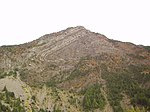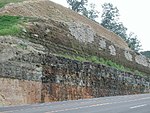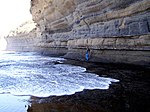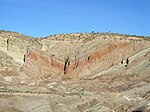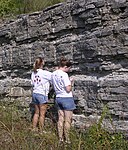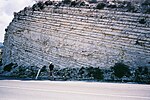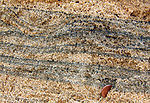Stratum: Difference between revisions
Fgnievinski (talk | contribs) No edit summary |
mNo edit summary |
||
| (10 intermediate revisions by 8 users not shown) | |||
| Line 1: | Line 1: | ||
{{ |
{{Short description|Layer of sediment, rock or soil with internally consistent characteristics}} |
||
{{other uses|Stratum (disambiguation)|Strata (disambiguation)}}{{More citations needed|date=May 2018}} |
{{other uses|Stratum (disambiguation)|Strata (disambiguation)}} |
||
{{More citations needed|date=May 2018}} |
|||
[[Image:Quebrada de Cafayate, Salta (Argentina).jpg|250px|thumb|Strata in [[Salta province|Salta]] ([[Argentina]])]] |
[[Image:Quebrada de Cafayate, Salta (Argentina).jpg|250px|thumb|Strata in [[Salta province|Salta]] ([[Argentina]])]] |
||
[[Image:Stratum.JPG|250px|thumb|Goldenville strata in quarry in [[Bedford, Nova Scotia|Bedford]], Canada. These are [[Middle Cambrian]] marine sediments. This formation covers over half of [[Nova Scotia]] and is recorded as being 8,800 m (29,000 ft) thick in some areas.]] |
[[Image:Stratum.JPG|250px|thumb|Goldenville strata in quarry in [[Bedford, Nova Scotia|Bedford]], Canada. These are [[Middle Cambrian]] marine sediments. This formation covers over half of [[Nova Scotia]] and is recorded as being 8,800 m (29,000 ft) thick in some areas.]] |
||
In [[geology]] and related fields, a '''stratum''' ({{plural form}}: '''strata''') is a layer of [[Rock (geology)|rock]] or [[sediment]] characterized by certain [[Lithology|lithologic]] properties or attributes that distinguish it from adjacent layers from which it is separated by visible surfaces known as either ''[[Bed (geology)|bedding surfaces]]'' or ''bedding planes''.<ref name="Salvador1994a">Salvador, A. ed., 1994. ''International stratigraphic guide: a guide to stratigraphic classification, terminology, and procedure. 2nd ed.'' Boulder, Colorado, The Geological Society of America, Inc., 215 pp. {{ISBN|978-0-8137-5216-7}}.</ref> Prior to the publication of the International Stratigraphic Guide,<ref name="Salvador1994a"/> older publications have defined a stratum as |
In [[geology]] and related fields, a '''stratum''' ({{plural form}}: '''strata''') is a layer of [[Rock (geology)|rock]] or [[sediment]] characterized by certain [[Lithology|lithologic]] properties or attributes that distinguish it from adjacent layers from which it is separated by visible surfaces known as either ''[[Bed (geology)|bedding surfaces]]'' or ''bedding planes''.<ref name="Salvador1994a">Salvador, A. ed., 1994. ''International stratigraphic guide: a guide to stratigraphic classification, terminology, and procedure. 2nd ed.'' Boulder, Colorado, The Geological Society of America, Inc., 215 pp. {{ISBN|978-0-8137-5216-7}}.</ref> Prior to the publication of the International Stratigraphic Guide,<ref name="Salvador1994a"/> older publications have defined a stratum as being either equivalent to a single [[Bed (geology)|bed]] or composed of a number of beds; as a layer greater than 1 cm in thickness and constituting a part of a bed; or a general term that includes both ''bed'' and ''[[Lamination (geology)|lamina]]''.<ref name="NeuendorfOthers2005a">Neuendorf, K.K.E., Mehl, Jr., J.P., and Jackson, J.A. , eds., 2005. ''Glossary of Geology'' 5th ed. Alexandria, Virginia, American Geological Institute. 779 pp. {{ISBN|0-922152-76-4}}.</ref> Related terms are ''substrate'' and ''substratum'' (pl.''substrata''), a stratum underlying another stratum. |
||
==Characteristics== |
==Characteristics== |
||
[[Image:SEUtahStrat.JPG|thumb|250px|The [[Permian]] through [[Jurassic]] strata in the [[Colorado Plateau]] area of southeastern [[Utah]] demonstrate the principles of [[stratigraphy]]. These strata make up much of the famous prominent rock formations in widely spaced protected areas such as [[Capitol Reef National Park]] and [[Canyonlands National Park]]. From top to bottom: Rounded tan domes of the [[Navajo Sandstone]], layered red [[Kayenta Formation]], cliff-forming, vertically jointed, red [[Wingate Sandstone]], slope-forming, purplish [[Chinle Formation]], layered, lighter-red [[Moenkopi Formation]], and white, layered [[Cutler Formation]] sandstone. Picture from [[Glen Canyon National Recreation Area]], Utah.]] |
[[Image:SEUtahStrat.JPG|thumb|250px|The [[Permian]] through [[Jurassic]] strata in the [[Colorado Plateau]] area of southeastern [[Utah]] demonstrate the principles of [[stratigraphy]]. These strata make up much of the famous prominent rock formations in widely spaced protected areas such as [[Capitol Reef National Park]] and [[Canyonlands National Park]]. From top to bottom: Rounded tan domes of the [[Navajo Sandstone]], layered red [[Kayenta Formation]], cliff-forming, vertically jointed, red [[Wingate Sandstone]], slope-forming, purplish [[Chinle Formation]], layered, lighter-red [[Moenkopi Formation]], and white, layered [[Cutler Formation]] sandstone. Picture from [[Glen Canyon National Recreation Area]], Utah.]] |
||
Typically, a stratum is generally one of a number of parallel layers that lie one upon another to form enormous [[thickness (geology)|thicknesses]] of strata.<ref name="Salvador1994a"/> The bedding surfaces (bedding planes) that separate strata represent episodic breaks in deposition associated either with periodic [[erosion]], cessation of deposition, or some combination of the two.<ref name="DaviesOthers2021a">Davies, N.S., and Shillito, A.P. 2021, ''True substrates: the exceptional resolution and unexceptional preservation of deep time snapshots on bedding surfaces.'' ''Sedimentology.'' published online 22 May 2021, doi: 10.1111/sed.12900.</ref><ref name="DaviesOthers2018a">Davies, N.S., and Shillito, A.P. 2018, ''Incomplete but intricately detailed: the inevitable preservation of true substrates in a time-deficient stratigraphic record.'' ''Geology'', 46, 679–682.</ref> Stacked together with other strata, individual stratum can form composite stratigraphic units that can extend over |
Typically, a stratum is generally one of a number of parallel layers that lie one upon another to form enormous [[thickness (geology)|thicknesses]] of strata.<ref name="Salvador1994a"/> The bedding surfaces (bedding planes) that separate strata represent episodic breaks in deposition associated either with periodic [[erosion]], cessation of deposition, or some combination of the two.<ref name="DaviesOthers2021a">Davies, N.S., and Shillito, A.P. 2021, ''True substrates: the exceptional resolution and unexceptional preservation of deep time snapshots on bedding surfaces.'' ''Sedimentology.'' published online 22 May 2021, doi: 10.1111/sed.12900.</ref><ref name="DaviesOthers2018a">Davies, N.S., and Shillito, A.P. 2018, ''Incomplete but intricately detailed: the inevitable preservation of true substrates in a time-deficient stratigraphic record.'' ''Geology'', 46, 679–682.</ref> Stacked together with other strata, individual stratum can form composite [[stratigraphy|stratigraphic units]] that can extend over hundreds of thousands of square kilometers of the [[Earth]]'s surface. Individual stratum can cover similarly large areas. Strata are typically seen as bands of different colored or differently structured material exposed in [[cliff]]s, road cuts, [[quarry|quarries]], and [[river]] banks. Individual bands may vary in thickness from a few millimeters to several meters or more. A band may represent a specific mode of [[Deposition (sediment)|deposition]]: river [[silt]], beach [[sand]], coal [[swamp]], [[sand dune]], [[lava]] bed, etc. |
||
==Types of stratum== |
==Types of stratum== |
||
| Line 15: | Line 16: | ||
==Gallery== |
==Gallery== |
||
{{gallery|width=150|height=150| |
{{gallery|width=150|height=150|File:Strata-french-alps.jpg|Strata on a mountain face in the French Alps |
||
|File:Strata-french-alps.jpg|Strata on a mountain face in the French Alps |
|||
|File:Rockstrata3435.JPG|Interstate road cut through [[limestone]] and [[shale]] strata in East [[Tennessee]] |
|File:Rockstrata3435.JPG|Interstate road cut through [[limestone]] and [[shale]] strata in East [[Tennessee]] |
||
|File:Rock_Strata.jpg|Rock strata at [[Depot Beach]], [[New South Wales]] |
|File:Rock_Strata.jpg|Rock strata at [[Depot Beach]], [[New South Wales]] |
||
| Line 30: | Line 30: | ||
* [[Bed (geology)]] |
* [[Bed (geology)]] |
||
* [[Geological formation]] |
* [[Geological formation]] |
||
** [[List of rock formations]] |
|||
* [[Geologic map]] |
* [[Geologic map]] |
||
* [[Geologic unit]] |
* [[Geologic unit]] |
||
Latest revision as of 15:59, 14 October 2024
This article needs additional citations for verification. (May 2018) |


In geology and related fields, a stratum (pl.: strata) is a layer of rock or sediment characterized by certain lithologic properties or attributes that distinguish it from adjacent layers from which it is separated by visible surfaces known as either bedding surfaces or bedding planes.[1] Prior to the publication of the International Stratigraphic Guide,[1] older publications have defined a stratum as being either equivalent to a single bed or composed of a number of beds; as a layer greater than 1 cm in thickness and constituting a part of a bed; or a general term that includes both bed and lamina.[2] Related terms are substrate and substratum (pl.substrata), a stratum underlying another stratum.
Characteristics
[edit]
Typically, a stratum is generally one of a number of parallel layers that lie one upon another to form enormous thicknesses of strata.[1] The bedding surfaces (bedding planes) that separate strata represent episodic breaks in deposition associated either with periodic erosion, cessation of deposition, or some combination of the two.[3][4] Stacked together with other strata, individual stratum can form composite stratigraphic units that can extend over hundreds of thousands of square kilometers of the Earth's surface. Individual stratum can cover similarly large areas. Strata are typically seen as bands of different colored or differently structured material exposed in cliffs, road cuts, quarries, and river banks. Individual bands may vary in thickness from a few millimeters to several meters or more. A band may represent a specific mode of deposition: river silt, beach sand, coal swamp, sand dune, lava bed, etc.
Types of stratum
[edit]In the study of rock and sediment strata, geologists have recognized a number of different types of strata, including bed, flow, band, and key bed.[1][5] A bed is a single stratum that is lithologically distinguishable from other layers above and below it. In the classification hierarchy of sedimentary lithostratigraphic units, a bed is the smallest formal unit. However, only beds that are distinctive enough to be useful for stratigraphic correlation and geologic mapping are customarily given formal names and considered formal lithostratigraphic units. The volcanic equivalent of a bed, a flow, is a discrete extrusive volcanic stratum or body distinguishable by texture, composition, or other objective criteria. As in case of a bed, a flow should only be designated and named as a formal lithostratigraphic unit when it is distinctive, widespread, and useful for stratigraphic correlation. A band is a thin stratum that is distinguishable by a distinctive lithology or color and is useful in correlating strata. Finally, a key bed, also called a marker bed, is a well-defined, easily identifiable stratum or body of strata that has sufficiently distinctive characteristics, such as lithology or fossil content, to be recognized and correlated during geologic field or subsurface mapping.[1][5]
Gallery
[edit]-
Strata on a mountain face in the French Alps
-
Rock strata at Depot Beach, New South Wales
-
Rainbow Basin Syncline in the Barstow Formation near Barstow, California. Folded strata.
-
Outcrop of Upper Ordovician limestone and minor shale, central Tennessee
-
Chalk Layers in Cyprus showing classic layered structure
-
Heavy minerals (dark) as thin strata in a quartz beach sand (Chennai, India)
-
Stratified Island near La Paz, Baja California Sur, Mexico
See also
[edit]- Archaeological horizon
- Bed (geology)
- Geological formation
- Geologic map
- Geologic unit
- Lamination (geology)
- Law of superposition
References
[edit]- ^ a b c d e Salvador, A. ed., 1994. International stratigraphic guide: a guide to stratigraphic classification, terminology, and procedure. 2nd ed. Boulder, Colorado, The Geological Society of America, Inc., 215 pp. ISBN 978-0-8137-5216-7.
- ^ Neuendorf, K.K.E., Mehl, Jr., J.P., and Jackson, J.A. , eds., 2005. Glossary of Geology 5th ed. Alexandria, Virginia, American Geological Institute. 779 pp. ISBN 0-922152-76-4.
- ^ Davies, N.S., and Shillito, A.P. 2021, True substrates: the exceptional resolution and unexceptional preservation of deep time snapshots on bedding surfaces. Sedimentology. published online 22 May 2021, doi: 10.1111/sed.12900.
- ^ Davies, N.S., and Shillito, A.P. 2018, Incomplete but intricately detailed: the inevitable preservation of true substrates in a time-deficient stratigraphic record. Geology, 46, 679–682.
- ^ a b Murphy, MA., and Salvador, A., 1999. International stratigraphic guide—an abridged version. Episodes, 22(4), pp.255-272.

